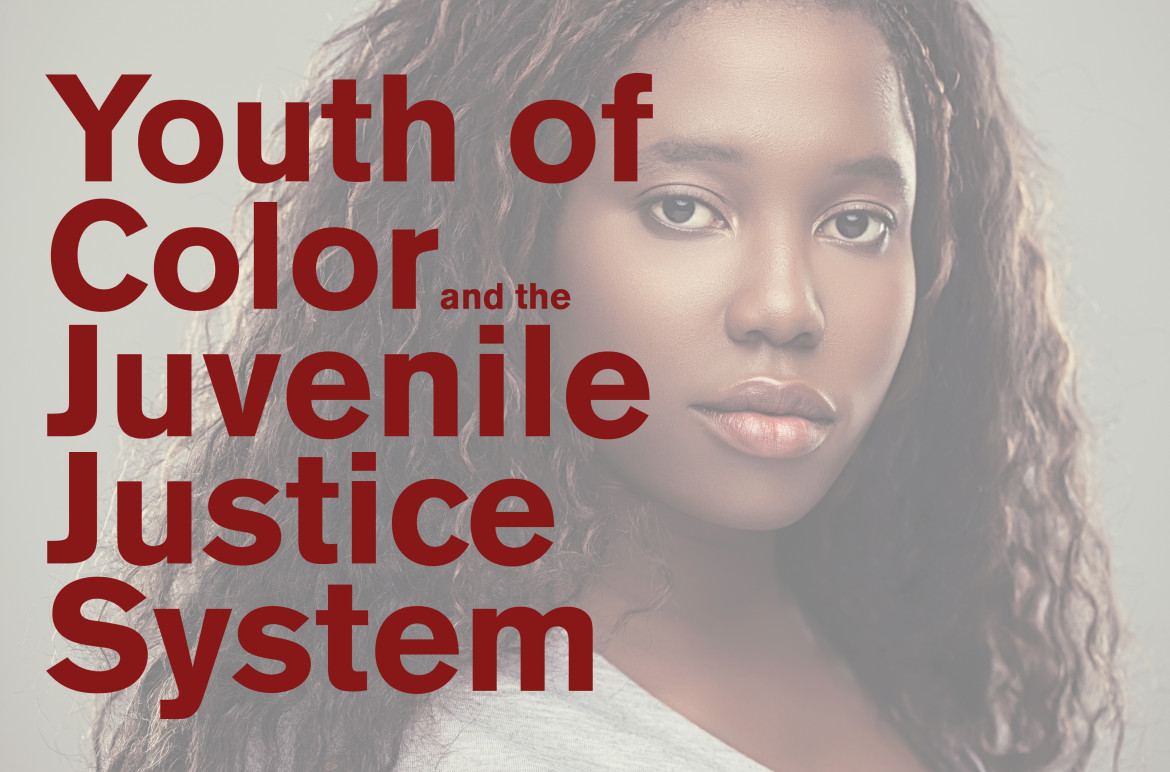
Reading through JJIE’s extensive coverage regarding racial and ethnic disparities in juvenile justice over the past month, reviewing its excellent new DMC resource hub, and scanning the available literature, it is impossible to avoid a couple of painful conclusions.
First, our nation’s juvenile courts and corrections systems remain deeply inequitable. More aggressive policing in low-income communities of color, counterproductive and racially-biased school disciplinary policies, weak legal representation and failed human service systems all inflate the rate at which youth of color enter the system. Then, once involved in the justice system, youth of color are subjected to a far more punitive and counterproductive variety of justice than white youth.
In its 2012 review of juvenile justice, the National Academy of Sciences found that even controlling for seriousness of the current offense, offending history and a host of other factors, “data consistently show that … race/ethnicity are associated with court outcomes, and that racial/ethnic differences increase and become more pronounced with further penetration into the system through the various decision points.” In addition, NAS concluded, “bias (whether conscious or unconscious) also plays a role,” and “many conventional practices in enforcement and administration [in the justice system] magnify these underlying disparities.”
Second, though the evidence of unequal justice is overwhelming – a stark deviation from our democratic ideals – our country is not making much if any progress to redress it. Just look at the latest census of youth in custody nationwide: More than two thirds of the kids confined by juvenile justice systems nationwide in 2011 were youth of color, even though white non-Hispanic youth still comprised 57 percent of the U.S. youth population. The confinement rate for black youth in 2011 was 4.6 times that of whites, up from 4.1 times a decade earlier. Already large disparities have worsened for Hispanic and Native American youth as well.
Fortunately, there may be some good news on the horizon. On March 28, Administrator Robert Listenbee and other top staff in the Office of Juvenile Justice and Delinquency Prevention will convene an unusual, perhaps unprecedented powwow with some of the nation’s leading juvenile justice reform advocates to discuss fundamental changes in OJJDP’s approach to racial and ethnic disparities.
This meeting presents a rare opportunity to initiate a meaningful, much-needed reboot of federal efforts to assure equal justice for youth of color.
For many years, it’s been an open secret that reformers and youth advocates are dissatisfied with the federal government’s lack of urgency in addressing the impossible-to-deny disparities in the treatment of youth of color in the justice system.
Yet, at least so far as OJJDP is concerned, the complaints have most often been muted, indirect, polite. As one long-time insider told me recently, “There’s not too many people who want to criticize OJJDP. They’re the only source of grant money in the field.” OJJDP also funds many or most of the organizations and consultants working on DMC issues, assisting states and localities to calculate disparities and hopefully solve them. So full-throated criticisms are rare.
Yet, the basic outlines of the critique are clear.
First, advocates and many juvenile justice practitioners are deeply disappointed in Congress’ failure to issue a clear and specific mandate requiring states and localities to take concrete action to remedy disparities. When first enacted in 1974, the federal Juvenile Justice and Delinquency Prevention Act did not include any provisions related to racial equity. Congress did amend the law in 1988 adding a requirement that states study their systems, determine if minority youth were overrepresented in juvenile facilities, and undertake reforms efforts if disparities were identified.
Four years later, Congress elevated this mandate by making it a “core requirement” of the law. But that requirement only demanded that states study confinement disparities and then “address” any problems they uncovered, with no definition of what that meant.
When it reauthorized the JJDPA in 2002, Congress expanded the DMC mandate’s focus from disparate minority confinement (looking only at which kids get locked up) to disparate contact (examining disparities at all phases of the delinquency court process). But Congress punted on the equally important need to strengthen the racial and ethnic equity mandate by insisting on meaningful concrete action to correct disparities. Since then, Congress has failed to reauthorize the law despite widespread consensus that many of its provisions are weak or dated, none more so than the DMC mandate.
When the JJDPA was first up for reauthorization in 2007, and again in 2009, the advocacy community banded together to promote specific amendments to JJDPA, including stronger DMC requirements, and it worked with sympathetic legislators to insert favorable provisions into legislative proposals.
By contrast, advocates have been far less vocal regarding OJJDP’s role, due in part to a lingering lack of leadership at OJJDP. The agency’s administrator under President George W. Bush, Robert Flores, had no background in juvenile justice and little appetite for reform. Then President Barack Obama neglected to appoint a leader for OJJDP throughout his entire first term.
Yet, the fact remains that even without congressional reauthorization of the JJDPA, OJJDP has the authority to make many of the changes advocates seek regarding racial and ethnic disparities, and the resources to significantly up its game on the issue.
In 2010, for instance, the Coalition for Juvenile Justice urged OJJDP to “craft explicit outcomes” for efforts to address disparities. “The other three core requirements of the JJDPA … are informed by associated implementation regulations and a set of metrics that must be substantially met for states to receive full federal funding,” CJJ wrote. “Such regulatory guidance and performance measures [should] be developed for DMC as well.”
In fact, OJJDP has a framework to guide states in meeting the DMC requirement. The agency advocates a five-step change model for addressing disparities, and it lists four requirements for states to be in compliance with the DMC mandate — comparing outcomes for youth of different racial and ethnic backgrounds against white youth (by calculating the “Relative Rate Index”) at successive stages of the justice process, assessing the causes of identified disparities, developing and implementing strategies to reduce disparities, and tracking outcomes.
In practice, however, states seem to be held accountable only for: (a) calculating the Relative Rate Index; and (b) submitting reports. Since 2006, only one state (Mississippi) and two territories (American Samoa, and the Northern Mariana Islands) have been penalized for failure to comply. As the Haywood Burns Institute — a leading think tank and consulting firm dedicated to combatting racial disparities — complained in a 2008 monograph, “The federal government set the bar so low that today nearly anything — regardless of how attenuated or remote from actual results — done in the name of ‘DMC’ is still considered adequate.”
If OJJDP is looking to strengthen its requirements regarding racial and ethnic equity, one target might be data reporting. As of 2005, just 13 states reliably reported on the ethnicity of youth at various stages of the juvenile court process, leaving them unable to accurately account for the share of youth with Hispanic heritage. Though this situation is improving, problems persist in many states. And OJJDP’s own National DMC Databook still provides no information whatsoever on Hispanic youth, the nation’s largest and fastest growing minority population.
OJJDP might also insist that states capture and analyze data at the local level, not just aggregate state figures. Most of the decisions affecting the treatment of youth — from arrest, diversion, detention, probation and placement — are typically handled at the local level. The dynamics of racial and ethnic equity operate far differently in Los Angeles than in Eureka, so state-level figures offer little benefit.
More fundamentally, OJJDP could promulgate (and really enforce) regulations that require meaningful action to reduce racial and ethnic disparities, following a clear set of protocols. It could require communities to establish active steering committees to examine disparities at the local level, meet regularly, develop action plans to address identified points of disparity and monitor the impact of their chosen strategies.
Beyond issuing new rules, OJJDP could also revamp its process for delivering technical support to states and local jurisdictions on racial and ethnic equity.
Advocates complain that the aid offered by OJJDP doesn’t adhere to important lessons gleaned through leading reform efforts, such as those conducted by the Burns Institute and the Center for Children’s Law and Policy. In these efforts, local leadership teams receive ongoing support from consultants with expertise not just in number crunching, but also in engaging system and community actors and facilitating deeper conversations to identify the hidden dynamics that often drive disparate treatment.
“You can’t just parachute in,” says James Bell, founder and executive director of the Burns Institute. Currently, Bell explains, when jurisdictions request technical assistance from OJJDP “they’re gonna send someone in for some period of time, a day or two, maybe a week, and then you’re done until your next request.”
By contrast, says Bell, “When you get us, we’re gonna be there every month, we’re gonna be asking ‘What’s the progress? Did you do that?’ And we’re going to help you do it. [It] has to be about moving a process. That’s why you need to be there a long time, to establish relationships and to move a process.”
Over the past decade, the Burns Institute has applied its intensive methodology in more than 100 jurisdictions nationwide, including many sites in the Annie E. Casey Foundation’s Juvenile Detention Alternatives Initiative. Likewise, through the Models for Change DMC Action network and other funders, the Center for Children’s Law and Policy has facilitated similar processes in many other jurisdictions. Often, these engagements have yielded encouraging results.
“We feel confident in the approach,” says Jason Szanyi, a staff attorney at CCLP. “We’re using it for a variety of funders. There’s faith in the process.”
To date, however, outside of a few smaller studies, none of these change models has ever been subject to an in-depth, independent evaluation to measure impact empirically, shed light on the characteristics of more vs. less successful sites, and examine critical factors in the timing or delivery of consulting support.

Photo courtesy of University of Maryland
Bart Lubow
Here again, OJJDP support could make a pivotal difference.
Whether this type of evaluation research will be discussed at the March 28 event is anyone’s guess. The session will include leading advocates such as Bell and Raquel Mariscal of the Burns Institute, Bart Lubow of the Casey Foundation and Juan Sanchez of Southwest Key, as well as researchers, judges and OJJDP staff.

Photo courtesy of Harvard University
Mark Soler
Another prominent participant will be Mark Soler, executive director of the Center for Children’s Law and Policy, which leads the DMC action network in MacArthur Foundation’s Models for Change project. Soler has a long commitment to the racial and ethnic disparities issue, which he has championed heartily at CCLP and as part of the Building Blocks for Youth initiative.
Soler, who got to know Listenbee as part of the Models for Change effort in Pennsylvania, has been deeply involved in the discussions leading up to the March 28 meeting. Reached by telephone, he expressed optimism.
“We’ve let Bob know that we see some problems [in how the agency has been addressing the racial and ethnic disparities challenge historically]. We’ve made some observations and recommendations, and Bob has been very interested,” Soler said.
“He has authority to make changes, and he realizes that there’s only a limited window to get things done,” Soler added. “So he’s doing what any responsible administrator would do — taking the ideas to his team, and to outside experts, after which he will make a final decision.
“We’re all eager to hear what that decision will be.”
DISCLOSURE: Past and current financial supporters of the Juvenile Justice Information Exchange may be quoted or mentioned in our stories. They may also be the subjects of our stories.
